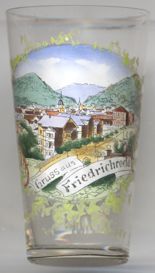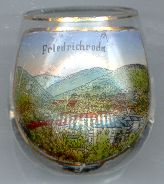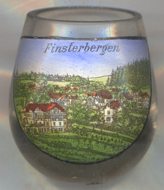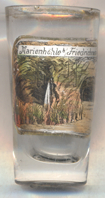

|
| DEUTSCHLAND | GERMANY |
| Bundesland: Freistaat Thüringen | Thuringia |
| Landkreis: Gotha |

 Friedrichroda is situated at an elevation of 407 m in the Thüringer Wald region. The municipality has a
population of about 7,400 (2017) and consists of the municipal districts Cumbach, Ernstroda, Friedrichroda and
Finsterbergen.
Friedrichroda is situated at an elevation of 407 m in the Thüringer Wald region. The municipality has a
population of about 7,400 (2017) and consists of the municipal districts Cumbach, Ernstroda, Friedrichroda and
Finsterbergen.
When in the 11th century castle Schauenburg was founded by the ladgraves of Thurigia, one of their henchmen, called Friedrich, was ordered to clear the woods near the castle and prepare the place for a new settlement. The village became known as Friedrichroda (the German word 'Rodung' means 'clearing'). After the landgraves had started to build the Wartburg (see Eisenach) they moved their residence to the new castle. The Benedictine monastery Reinhardsbrunn was founded in 1089. The abbot wanted to grant Friedrichroda the privilege of holding markets, but the plan had to be dropped after threats by the nearby towns of Waltershausen and Gotha. During the13th century the monastery was one of the richest in the country and and at that time also served as the burial place of the Thuringian landgraves. Around 1600 Friedrichroda finally obtained the status of a market town despite repeated protest by Waltershausen and Gotha. When the area had become in possession of the Dukes of Saxe-Weimar in 1572, Friedrichroda received a town charter in 1597. After the partition of Saxe-Weimar in 1640 the town became part of the duchy of Saxe-Gotha.
 Mining for iron and other ores was done until 1855. Since about 1840 the well wooded area began to attract tourists. The first hotels and guesthouses
were opened in 1844. The first bath houses folloed in 1889. Since about 1900 the spa activities were extended to winter tourism. Both
world wars caused severe declines for the town, but since 1954 Friedrichroda was developed anew by the East German government and
finally became the second-largest recreation place in the German Democratic Republic.
Mining for iron and other ores was done until 1855. Since about 1840 the well wooded area began to attract tourists. The first hotels and guesthouses
were opened in 1844. The first bath houses folloed in 1889. Since about 1900 the spa activities were extended to winter tourism. Both
world wars caused severe declines for the town, but since 1954 Friedrichroda was developed anew by the East German government and
finally became the second-largest recreation place in the German Democratic Republic.
Friedrichroda is proud to be the place where Christian Friedrich Ludwig Buschmann invented the harmonica (in 1821) and the accordeon (in 1822).


 Marienglashöhle ('Our Lady's Glass Cave') [left] is located
about halfway between Friedrichroda and Bad Tabarz in the Thuringian Forest.
For the most part, it is not a natural cave but consists of cavities created by gypsum and copper mining. The first
galleries were created in 1775 wit the intention of mining copper. No copper was found but in 1788 important deposits
of gypsum were discovered that also included magnificent crystals and druses of almost completely translucent selenite
(in German called 'Marienglas',
Marienglashöhle ('Our Lady's Glass Cave') [left] is located
about halfway between Friedrichroda and Bad Tabarz in the Thuringian Forest.
For the most part, it is not a natural cave but consists of cavities created by gypsum and copper mining. The first
galleries were created in 1775 wit the intention of mining copper. No copper was found but in 1788 important deposits
of gypsum were discovered that also included magnificent crystals and druses of almost completely translucent selenite
(in German called 'Marienglas', ![[scale]](lineal.jpg)